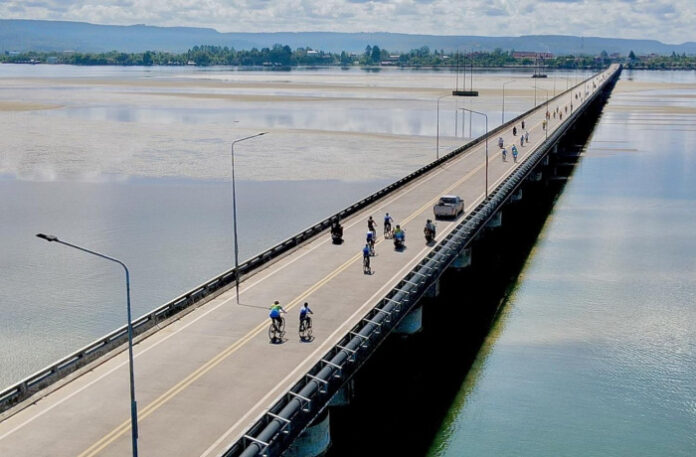A bird’s eye view of the Koh Kong bridge in Cambodia that crosses the Prek Kaoh Pao River. Koh Kong is a border province where people from Thailand can cross at the Ban Hat Lek checkpoint in Trat’s Khlong Yai district.
After facing a slump for almost three years, economic activity in several border provinces is getting back on track, especially in Trat — which is a major tourist destination and a gateway to Cambodia.
Travellers use the Ban Hat Lek border checkpoint in Trat’s Khlong Yai district to reach Cambodia’s Koh Kong province which is also famous for natural and cultural attractions as well as outdoor activities.
Provincial authorities organised a Thai-Cambodian friendship cycle tour in late July this year to deepen the relationship between the countries in mutual tourism destinations with more than 500 participants.
In addition to tourism, border trade in the area has also flourished.
Before the pandemic, annual border trade had risen to between 30 billion and 40 billion baht. Now that the virus curbs have been rolled back, the outlook for trade with the neighbouring country is bright and Thai businesses are being urged to prepare for massive opportunities.
Cambodia’s economic growth and infrastructure development over the past 10 years have been remarkable. Development in Koh Kong province has made a leap following the launch of the Koh Kong Industrial Estate.
Inaugurated on Dec 17, 2012 and operated by Koh Kong SEZ under the LYP Group, the industrial estate has attracted more than 5 billion baht from four foreign companies including KKN Apparel of Thailand.
Located about 45 kilometres from Khlong Yai district, the aim is to attract foreign direct investment and create jobs for Cambodians. Currently about 12,000 workers are employed.
Jiranan: Plenty of opportunities
Impressive growth
Thitidej Tongpatara, vice-president of Koh Kong SEZ, said Cambodian people have high purchasing power due to the economic growth spurred by foreign investments including Chinese investors who pour money into sectors such as hotel and property development.
Minimum wages in Koh Kong are US$192 per month, or 7,100 baht, but together with living allowances and overtime payments, Cambodian workers should be paid $258-$259 or 9,583 baht per month.
The young workforce is looking for jobs in Koh Kong because of the better wages and new job openings, he added.
With a stable source of income and the strengthening of the dollar, Cambodian people have more spending power and demand for Thai products is expected to increase in tandem. This can deliver a positive effect for the economy, he said.
“People in Koh Kong cross the border to Thailand more since the lifting of Covid-19 restrictions. They come here to travel, shop, see doctors and a lot more. Some go shopping for brand-name products at a mall in Chanthaburi. Local businesses are back to life,” he said.
Also, facilities at Ban Hat Lek border checkpoint were improved and paperwork handling streamlined to handle demand for travel and the movement of goods, he said.
Koh Kong has also invested in the development of public utilities, infrastructure and transport links over the past several years, he said. It now has its own local power supply, instead of depending on imports from Thailand.
Work is underway to connect Road No.48, which has been in use for a long time, to Road No.4, which has been upgraded as an expressway linking Phnom Penh and Sihanoukville.
More piers are being developed for passenger and fishing vessels while an airport construction project is in the preparation stage.
The Dara Sakor project, with Chinese enterprises as investors, is underway. The investments have made a positive contribution to the socio-economic development of Koh Kong, he said.
Mr Thitidej said he also hoped Thai-Cambodian talks on the development of energy resources in the oil-rich overlapping claims area in the Gulf of Thailand will make progress and both countries will find ways to cooperate.
Thitidej: Think of purchasing power
Business opportunities
On Dec 9, a business matching event was organised in Trat’s Muang district bringing together Thai business leaders in the eastern region and their potential partners from Cambodia and Vietnam.
The trade seminar was part of efforts to elevate the grassroots economy in the east and link the country’s Eastern Economic Corridor (EEC) to the growing cross-border trade in the region.
Speaking at the event, Jiranan Wongmongkol, a former minister counsellor for commerce, Office of Commercial Affairs, Royal Thai Embassy in Cambodia, urged Thai companies to grab business opportunities in Cambodia, which is one of the most vibrant economies in the region with high political stability.
The eastern coast of Thailand, which comprises Chon Buri, Rayong, Chanthaburi and Trat, borders Cambodia’s so-called Four K provinces — Koh Kong, Kampong Som (Sihanoukville), Kep and Kampot where it links with Vietnam’s Phu Quoc island.
Koh Kong’s local economy, in particular, has been robust due to a wide array of investments and infrastructure projects, not to mention Dara Sakor, which is a comprehensive investment and development zone with a deep-sea port and airport.
Ms Jiranan said these four provinces, especially Sihanoukville, have attracted Chinese investors.
With about five million Chinese living there, it presents business opportunities for Thai entrepreneurs particularly in the fields of tourism, raw materials, food and agriculture products.
“They can reach out to southern Vietnam including Phu Quoc if we develop a navigation route linking our eastern region to Cambodia and Vietnam. This will be a boon for tourism,” she said.
Potential sectors
Thai firms seeking to grow their businesses in Cambodia need to understand the different lifestyles of Cambodian people and their purchasing power, said Ms Jiranan.
Those who earn $200-300 per month make up for 50%, while high-income earners, despite being limited in number, are willing to spend. Middle-income earners who make around $500 tend to spend on goods such as cars and houses.
Cambodian people looking to buy property have turned away from the so-called Four K provinces due to soaring land prices.
Holiday-makers also prefer Trat to these provinces because of high costs and ease of travel as Trat also borders Cambodia’s Pouthisat and Battambang.
Education and healthcare are among potential sectors for Thai investors, according to Ms Jiranan.
The Cambodian government wants to increase the birth rate among its citizenry, which presents a chance for Thai firms to invest in the education sector.
Moreover, Cambodians are interested in learning other languages as part of their skill enhancement and to bolster their job opportunities.
“Healthcare is also an interesting sector. Each family has several children and they are willing to pay for their children’s health. Babycare products are also in high demand. Unlike in Thailand, where baby products are offered along with other goods, Cambodia has babycare outlets,” she said.
She also said Cambodian Prime Minister Hun Sen, who has served in the position for over three decades, is unlikely to face any major challenges, which can ensure political stability and economic continuity.
“Thailand is a major trader of Cambodia, so it is a really good opportunity to invest. There are several border crossings from Ubon Ratchathani to Trat that can accommodate economic activities,” she said.










